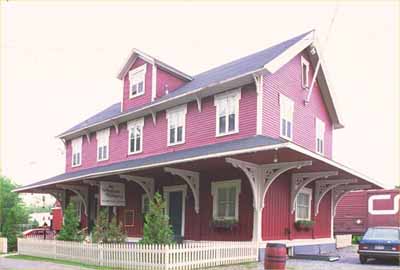Rothesay Railway Station (European and North American) National Historic Site of Canada
Rothesay, New Brunswick

General view
(© Parks Canada Agency / Agence Parcs Canada, 1993.)
Address :
Rothesay, New Brunswick
Recognition Statute:
Historic Sites and Monuments Act (R.S.C., 1985, c. H-4)
Designation Date:
1976-06-15
Dates:
-
1858 to 1860
(Construction)
Event, Person, Organization:
-
European and North American Railway
(Organization)
Other Name(s):
-
Rothesay Railway Station (European and North American)
(Designation Name)
Research Report Number:
1973-K, 1976-051E, 1974-C, 1998-043
Plaque(s)
Existing plaque: Rothesay, New Brunswick
Although a railroad to connect the ports of Saint John and Shediac had been proposed in the 1840s, it was not until the formation of the European and North American Railway in 1852 that the line was begun. Even then construction was delayed and the railway was not opened until 1860 although the line from Saint John to Rothesay had been completed two years before. The railroad was taken over by the Canadian government after Confederation and later merged with the CNR. This building, begun in 1858, is a good surviving example of a number two standard station designed by the European and North American Railway.
Description of Historic Place
The Rothesay Railway Station (European and North American) is a two-and-a-half-storey, Neo-Gothic, railway station with stationmaster's quarters above. It was built in the mid-19th century and is centrally located in the community of Rothesay. The formal recognition consists of the railway station building only.
Heritage Value
Rothesay Railway Station (European and North American) was designated a national historic site in 1976 because it commemorates the development of the Maritime Railways and it is a good surviving example of a number two standard station designed by the European and North American Railway (ENAR).
Rothesay Railway Station (European and North American) was one of the first stations built by the newly formed ENAR along its Saint John to Shediac line. Built to a standard design, the Rothesay station is one of a small number of surviving ENAR stations built before 1860 that represent the earliest surviving examples of railway architecture in the Maritime provinces.
Sources: Historic Sites and Monuments Board of Canada, Minutes, 1976; Historic Sites and Monuments Board of Canada, Plaque Text, 1980.
Character-Defining Elements
The key elements that relate to the heritage value of this site are:
its overall form, based on a straightforward, two-storey, gable-roofed structure with a deep platform canopy wrapping around all sides of the building above the ground floor, its rectangular plan, with station agent's bay projecting from the track side, its symmetrical, five-bay facade with uniform fenestration, the wide-eaved platform canopy extending along all sides of the building and supported on large, decorative brackets, its Neo-Gothic detailing, expressed in: the wide eaves of the platform canopy; the large brackets with trefoil inserts supporting the platform canopy; the smaller brackets supporting the shallower eaves of the gable roof; wide bargeboards with finials at the gable peaks; decorative wood trim with dripstones around window openings, its wood construction and horizontal wood siding.